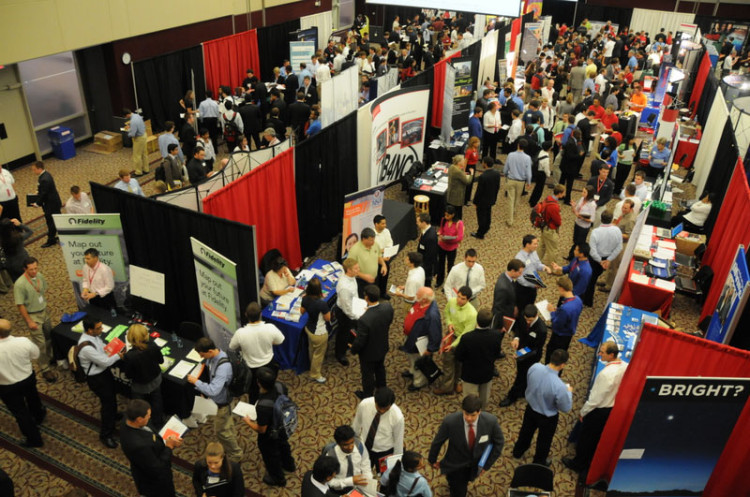It’s the season for job fairs. These are mechanisms for companies and candidates to screen each other and for both sides to get a feel for the market. They are an interesting combination of informational interview, actual interviews and networking. The skill is identifying which is which and applying the correct strategy.
Today, there is discussion about how useful they are for employers. Many are finding that college graduates lack basic skills for white collar jobs and are considering other forms of assessment. But if there is one for your sector or in your region, as a job seeker it’s an additional opportunity to make contact with organisations and therefore worth doing.
Here are 7 tips on how to make the most of job fairs
1. Register for the Fair
Some job fairs allow candidates to register for the event, usually online, when they can pre-submit a CV. This gives companies an opportunity to screen applicants and identify the individuals they want to meet. There is no guarantee that this will take place, but if offered the chance, take advantage of the process. Always check for late company registrations – this can happen.
2. Be strategic
Many job seekers don’t treat job fairs seriously or strategically and attend and wander around in ” go-see” mode. This can be unproductive and waste huge amounts of time. Attendance at job fairs is usually high. Lines get long, especially for high-profile companies. If you can get the layout of the exhibition centre, plan a route around the fair. They can also be very tiring.
Identify target companies before hand, and if possible connect with recruiters and hiring managers. Generally the ones attending job fairs tend to be more junior and not final decision makers. Nevertheless, they will be influencers and will make a difference to whether candidates are advanced in the process.
Devise a plan for the day, perhaps going to see your top choice companies in the morning before the recruitment team get hiring fatigue and while you are at your sparkling best. You can always call by at the end of the day to make sure they remember your face.
3. Updated CV
For job fairs use a CV with a photo so the interviewer will connect you and your CV when he/she is back at the office. Take multiple CVs – very often you will need a different one tailored specifically for each organisation. There may also be several people at the stand.
You can send it on the spot if necessary.
Back at base these CVs will be inputted into a data base, so strong key-worded resumes are vital for easy future retrieval.
4. Interview attire
Dress as if you were going for a formal interview or smart casual. What seems like an informal chat is an interview by another name. Most students don’t dress to impress and become a blur of T- shirts, jeans and the ubiquitous back pack. Stand out from the crowd.
5. Prepare, Perfect, Pitch
Preparation is critical to success. You may only have two to five minutes to sell yourself to really need to make the most of your time. Use your 30 second commercial to create a dialogue. You may need multiple versions. Don’t forget general common courtesies and body language, especially eye contact, handshake and smile are key! As are all the usual common courtesies. If you are going to practise anything at all – make sure your basics are in place.
Prepare your own questions to show that you have researched the company and ask what they are looking for and what you need to do to make the cut. If you feel the interview is not going as planned – perhaps they are not looking for candidates in your discipline for example, you can always ask for a network referral.
Some companies offer a “Golden Hello” to candidates they are really interested in and offer signing on bonuses. Check this out beforehand rather than raise it at the interview, unless you already have a similar offer from another organisation. Discounts on student loans or other financial incentives, are great perks at the start of a career.
6. Network
Job fairs are great opportunities for networking and informational interviews. If there is a programme of career workshops or other presentations sign up. You can get a lot of excellent tips and maybe network with the presenters. If you see a stand with no one in line but not on your target list, you can always chat to the company representatives. It helps build up your general market knowledge and networking skills in a low-risk environment.
Yes, of course it’s more fun standing in a queue with your friends, but you risk becoming part of an amorphous group. You want to stand out! Do not take a parent. If a parent does drive you – leave them in the coffee lounge while you take care of “business”.
Have some business cards printed to distribute. If you are studying, use your USP under your name.
7. Follow-up
Many job-seekers fail to follow-up after interviews or connections made at job fairs. Ask for a business card of the company representatives and if you can connect with them on LinkedIn. That’s another way to re-enforce an impression. Your own profile should be impeccable, carrying the same photo as your CV.
You can send any contact a thank you email with a copy of your CV. Use that email to reposition yourself and to re-confirm your interest, re-iterating your main skills. I have seen recommendations to leave a voice mail on a mobile phone. I suggest that would depend on how well you connected with the interviewer. Some may find it intrusive. If you know the next steps also confirm those – especially timeframes. Strong candidates are being courted early and fast by top companies, so it’s important to have an understanding of the process, especially if you receive multiple indications of interest.
Good luck!





